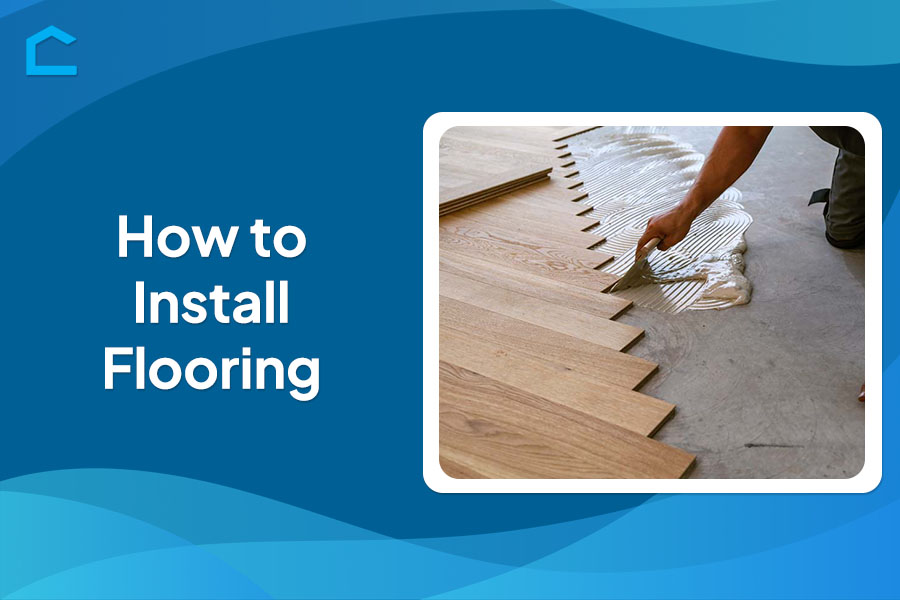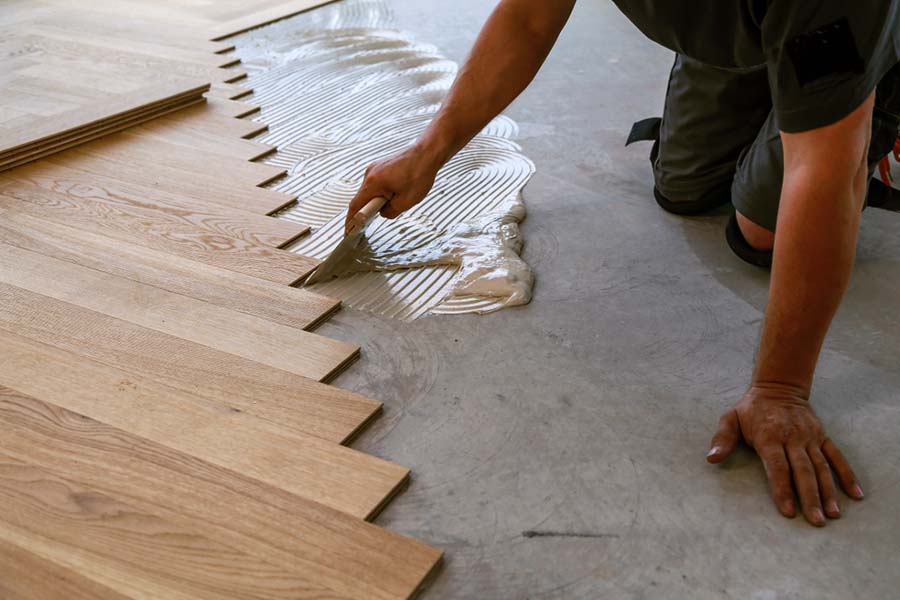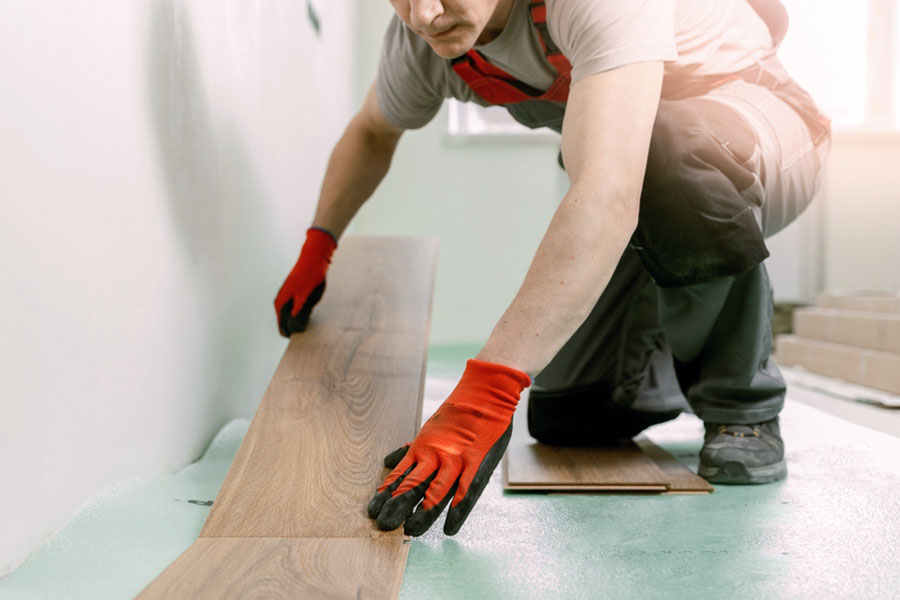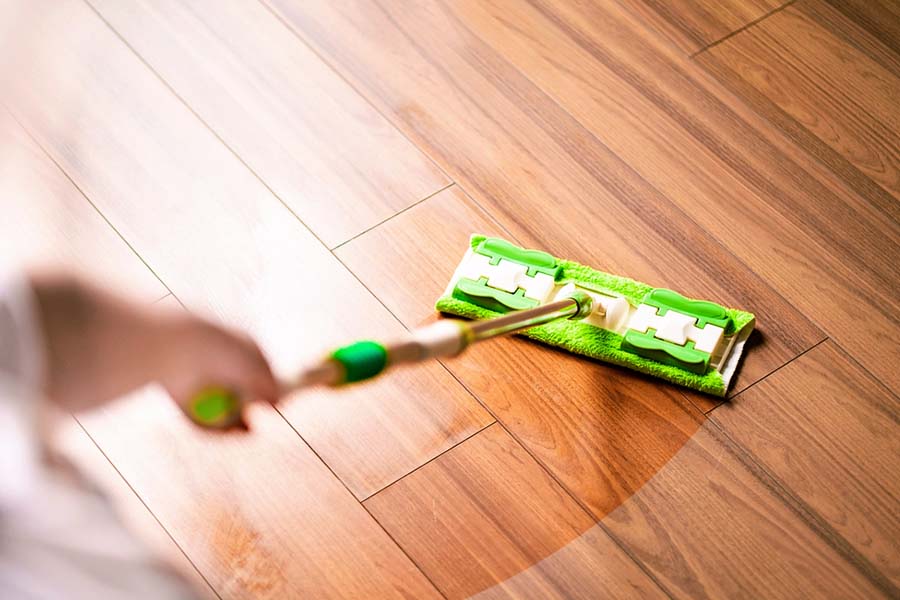How to Install Flooring

Are you ready to transform your space with new flooring? Installing flooring may seem intimidating. But with the right tools, materials, and guidance, you can achieve professional-looking results.
In this article, we’ll walk you through the process of how to install flooring step by step. We’ll start by discussing the importance of proper preparation, including subfloor inspection, moisture testing, and layout planning. Next, we’ll dive into the various types of flooring materials, such as hardwood, laminate, vinyl, and tile, and the specific techniques required for each.
You’ll also learn tips and tricks for ensuring a flawless installation, from cutting and fitting planks to creating a seamless finish. Get ready to discover the secrets to achieving stunning, long-lasting floors that will enhance the beauty and value of your home.

Source: shutterstock.com / Photo Contributor: Maleo
How to Install Flooring
Installing flooring involves preparing the subfloor, laying down underlayment, and placing the flooring material. Start by ensuring the subfloor is clean and level. Then, add an underlayment for cushioning and moisture protection.
Begin laying the flooring in one corner, interlocking pieces while leaving space for expansion. Cut pieces to fit at the ends of rows and around obstacles. Finish by installing transition strips where the flooring meets other surfaces. Always follow manufacturer instructions for specific flooring types.
Preparing for Flooring Installation
Accurately measure the room’s length and width, then calculate the square footage. Add an extra 10% for cuts and waste. Evaluate the subfloor by inspecting it for damage, unevenness, or moisture issues. Repair or replace the subfloor if necessary, ensuring it’s clean, dry, and level.
Choosing the right flooring type
- Durability and traffic level – Consider the expected foot traffic in the room and choose a flooring material that can withstand the anticipated wear and tear.
- Aesthetic preferences – Select a flooring color, pattern, and texture that complements the room’s style and decor. When choosing plank or tile size, take into account the room’s dimensions.
- Moisture resistance – Assess the room’s moisture level and potential for water exposure. If necessary, opt for a moisture-resistant flooring material.
Gathering tools and materials
Collect necessary tools:
- Tape measure
- Pencil
- Straight edge
- Saw
- Rubber mallet
- Spacers
- Tapping block
Purchase enough flooring material to cover the measured square footage, including:
- Underlayment (if required)
- Moisture barrier (if required)
Acquire any additional materials:
- Adhesives
- Transition strips
Proper planning and preparation, including assessing the space, choosing the right flooring type, and gathering tools and materials, will ensure a smoother and more successful flooring installation project.
Guidelines for Subfloor Preparation
Where to start flooring in a house? Preparing the subfloor is crucial for successful flooring installation. A clean, level subfloor is essential. Dirt, debris, and uneven surfaces can cause issues like adhesion problems and uneven wear.
Thoroughly clean the subfloor by sweeping and scrubbing to remove all contaminants. This ensures a proper bond and prevents future problems. Rinse well to remove any cleaning product residues that could interfere with the flooring adhesive.
Inspect the subfloor and use a self-leveling compound to address any uneven areas. Allow it to fully cure per the manufacturer’s instructions for a smooth, even surface. This step is important to avoid issues like bumps or dips showing through the finished floor.
Proper subfloor preparation, including cleaning and leveling, is a critical step that sets the stage for a successful flooring installation. Taking the time to do it right will pay off in the long run.
General Installation Tips
- Acclimating flooring materials is crucial – It allows them to adjust to the temperature and humidity of the installation site. Failure to acclimate can lead to issues like expansion, contraction, gaps, or buckling. Follow the manufacturer’s guidelines for the proper acclimation time, typically 48-72 hours.
- Precise measurement is key – Carefully measure the room dimensions, including length, width, and irregularities. Add 5-10% to your calculated square footage to account for cuts and waste. Miscalculating can result in costly mistakes.
- Inspect the subfloor before installation – Look for uneven or damaged areas that need to be addressed. Minor issues can be fixed with leveling compounds, but severe defects may require more extensive repairs or replacement.
Consulting a professional is advisable in these cases. Proper preparation, including acclimation, accurate measurement, and subfloor evaluation, is essential for a successful flooring installation.
How to Install Flooring
Hardwood flooring
Solid and engineered hardwood flooring can be installed using a few different methods. Solid hardwood is typically nailed or stapled to the subfloor, starting with a straight reference line and arranging the boards in a staggered pattern.
Wood glue is used at the joints, and each board is carefully secured in place. Engineered hardwood can be installed similarly. However, some products also allow for a glue-down installation.
In this method, the adhesive is applied directly to the subfloor. Regardless of the method, it’s crucial to leave an expansion gap around the perimeter to allow the hardwood to naturally expand and contract.
Laminate flooring
Laminate flooring is usually installed using a click-and-lock system. The first row of planks is laid with the proper expansion gap. Each subsequent plank is then angled into the groove of the previous one. Finally, the planks are pressed down firmly to lock them together.
The end joints should be staggered for a more natural look, and a tapping block can be used to ensure a tight fit between the planks. When cutting laminate planks, it’s best to score the surface several times with a sharp utility knife or laminate cutter. Then, snap the piece along the scored line to prevent chipping or cracking.

Source: shutterstock.com / Photo Contributor: Parilov
Tile flooring
Proper subfloor preparation is key for successful tile installation. The subfloor should be clean, level, and free of debris. A suitable underlayment, like a cement backer board, should be applied to create a stable surface.
Tiles are then laid in a staggered pattern. The recommended thin set mortar is applied to the subfloor. Spacers are used to maintain consistent grout lines. Once the tiles are set, grout is applied between the joints using a rubber float. Finally, a penetrating sealer is used to protect the tile surface.
Vinyl flooring
Sheet vinyl is installed by laying the material and cutting it to fit the room. Then, apply the recommended adhesive to the subfloor. Carefully position the sheet and smooth out any air bubbles. Vinyl tiles and planks are typically installed using a self-adhesive backing or a separate adhesive.
The first piece is aligned, and subsequent pieces are pressed firmly into place. When cutting vinyl flooring, a sharp utility knife or vinyl cutter should be used, scoring the surface several times. Then snapping the piece along the scored line to prevent ragged edges.
Finishing Touches
Baseboards and trim play a crucial role in covering the expansion gap and protecting the flooring edges. They can also enhance the visual appeal by complementing the flooring style. Proper installation is key to ensure a seamless, uniform appearance.
Sealing the flooring is an important final step to protect the surface and maintain its appearance. Different sealants are recommended based on the flooring type, creating a durable, scratch-resistant surface. Regular maintenance of the sealant extends the flooring’s lifespan.
Attention to detail is crucial for the finishing touches, such as precise measurement and application of baseboards, trim, etc. Sealants elevate the overall look and feel of the flooring installation, resulting in a functional and visually appealing space.
Cleaning and Maintenance
After installation, thoroughly clean the area by sweeping first, then damp mopping with a specialized floor cleaner as needed to remove any dust, debris, or excess materials.
For hardwood floors, sweep weekly and damp mop every few months, periodically applying a sealant or polish to maintain the surface. Laminate and vinyl flooring require regular sweeping and damp mopping with a specialized cleaner, addressing stubborn stains or scuffs carefully.
Tile and stone floors need sweeping, pH-neutral mopping, and periodic sealing to protect the surface from stains and wear. Proper cleaning and maintenance tailored to the flooring type is essential for longevity and appearance.

Source: shutterstock.com / Photo Contributor: Gokhan Y
Conclusion
Installing flooring is a valuable skill that can save you money and provide a sense of accomplishment.
By meticulously following the steps outlined in this guide, you can confidently tackle this project, whether working with hardwood, laminate, vinyl, or tile. Take your time, measure carefully, and pay close attention to details for a professional, flawless finish.
This comprehensive guide has provided you with the necessary knowledge to approach this rewarding home improvement project with confidence. Understanding how to install flooring on your own, with the right tools, materials, and expertise, you can transform your space into a stunning environment that you’ll be proud to show off.
Your newly installed floors will not only enhance the aesthetics but also add value to your home for years to come. Embrace the challenge, and enjoy the beauty of your handiwork. Happy flooring!
